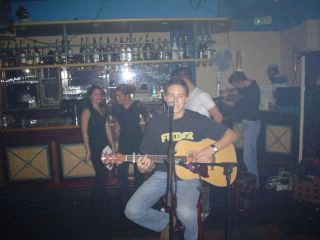Ladysmith Black Mambazo: An African Cultural Explosion
“Welcome to the solution of this African contribution” are the opening lyrics for “Knowing the other one” by Jazzworx. Although they are clearly referring to themselves, I feel no truer words were spoken to represent the contribution made to international music by Ladysmith Black Mambazo. Their reputation precedes them as highly successful collaborators with Paul Simon amongst other popular acts, the main performers at Nelson Mandela’s release and a musical history dating back nearly 45 years now. Potentially the most remarkable aspect of their story is that they achieved this phenomenal success despite coming from abject poverty in South Africa and still to this day recruit new members of this nine man acapella choir from candidates with exactly this heritage. They stand among only a handful of internationally recognised stars that came from incredibly poor African backgrounds such as Yossou N'Dour.
For a number of years I had been keen to see them live and finally had the chance last month in a rather aristocratic concert hall in The Hague. Despite my questioning of their relative popularity in Europe I was pleased to find that the hall filled up very quickly.
Despite the setting the performance itself on the whole was a very lucid and unpretentious affair. Between songs the members would chat and drop a few dance moves and go and get glasses of water which to me demonstrated their dedication solely to the music not to aesthetics.
Before I attended a friend of mine commented that he simply didn’t like acapella choirs which I accepted simply as a matter of opinion but in truth the style of music cannot be compared or contrasted by any western standards or setups such as tenors, altos and sopranos etc. Instead each member has a harmony and distinct vocal riffs which he specialises in. They also to choose to sing very close to the microphone which can lead to unwanted distortion but instead it served to amplify the really rich tonal quality and depth to the music. At a number of points they stepped back from the bank of microphones to sing acoustic. Perhaps after the full sound I had previously experienced I was duped into believing the tone would be equally rich and strong but I was some what disappointed that even as close as the ninth row I lost a lot of the texture. Many would say that my expectations are too high to believe that the sound would fill the room without amplification but their have been examples of flamenco guitarists performing in London’s Albert Hall and filling that space without a microphone. Despite the acoustic intermissions diminishing the overall full texture of the music it did mean that the droning quality of their music was alleviated somewhat and it was nice to hear, if only faintly, some different parts more clearly.
With regard to their set list I was pleased that they weren’t swayed by European demands for well known songs and performed a majority of songs in Zulu but also that they did intersperse it with some of their better known pieces, which are often in English.
All in all it was a fantastic experience and was one of those performances which left everyone chatting about it fervently on their way to their cars and hopefully for much longer after that.
For a number of years I had been keen to see them live and finally had the chance last month in a rather aristocratic concert hall in The Hague. Despite my questioning of their relative popularity in Europe I was pleased to find that the hall filled up very quickly.
Despite the setting the performance itself on the whole was a very lucid and unpretentious affair. Between songs the members would chat and drop a few dance moves and go and get glasses of water which to me demonstrated their dedication solely to the music not to aesthetics.
Before I attended a friend of mine commented that he simply didn’t like acapella choirs which I accepted simply as a matter of opinion but in truth the style of music cannot be compared or contrasted by any western standards or setups such as tenors, altos and sopranos etc. Instead each member has a harmony and distinct vocal riffs which he specialises in. They also to choose to sing very close to the microphone which can lead to unwanted distortion but instead it served to amplify the really rich tonal quality and depth to the music. At a number of points they stepped back from the bank of microphones to sing acoustic. Perhaps after the full sound I had previously experienced I was duped into believing the tone would be equally rich and strong but I was some what disappointed that even as close as the ninth row I lost a lot of the texture. Many would say that my expectations are too high to believe that the sound would fill the room without amplification but their have been examples of flamenco guitarists performing in London’s Albert Hall and filling that space without a microphone. Despite the acoustic intermissions diminishing the overall full texture of the music it did mean that the droning quality of their music was alleviated somewhat and it was nice to hear, if only faintly, some different parts more clearly.
With regard to their set list I was pleased that they weren’t swayed by European demands for well known songs and performed a majority of songs in Zulu but also that they did intersperse it with some of their better known pieces, which are often in English.
All in all it was a fantastic experience and was one of those performances which left everyone chatting about it fervently on their way to their cars and hopefully for much longer after that.


0 Comments:
Post a Comment
<< Home